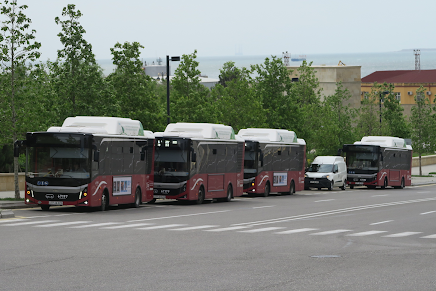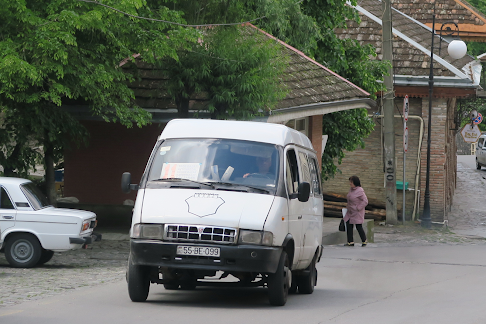BakuBus MMC 15599 (99·JU·284). BMC Procity 12 CNG, new in 2019. One of 510 in service with the operator. Operating service 125 from 28 May metro station to the southern suburb of Lokbatan, a distance of 21km with a 10-minute headway. Photographed on Neftchilar Avenue heading out of the city.
The Republic of Azerbaijan sits on the borders of Europe and Asia with a coastline on the Caspian Sea; land borders with the Republic of Dagestan, Iran, Georgia and Armenia; has the enclave of Nakhchivan. With a population of 10.2 million the capital is Baku, main language is Turkic and the currency is the manat (1 manat = 47p). This former part of the Soviet Union is now a ‘democratically elected one party state’, rich in gas and oil reserves.
The Nakhchivan Autonomous Republic is a land locked nation situated in the southwest end of the Lesser Caucasus and covers an area of 5,500 KM² with a population of 444,400. It has a 246km long border with Armenia; 204km with Iran and 11km with Turkey. Since the second Nagorno-Karabakh war of 2020 and the 2023 Azerbaijani offensive, the Republic is only accessible to foreigners by air. Biblically, Nakhchivan is said to be the resting place of the Prophet Noah and that the cleft peak of Mount Ilandag was carved out by Noah's Ark. The Republic is also considered one of the least polluted countries in the world, with no major industries and vast areas given over to mountains and national parks.
The capital of Azerbaijan, Baku, has a population of 2.62 million. The terrain is hilly, levelling out on the seafront with a 14km long promenade. The streets are often narrow, and the architecture is a mix of ancient, Soviet and spectacular modern. Public transport includes a two-line metro system, 70 city bus routes, 124 suburban routes, 6 minibus routes in the city and 17 in the suburbs; carries 350,000 passengers daily and is overseen by Baku Transport Agency (BTA). Tickets are purchased using the ‘BakkaKART’, a pre-loaded smart card. The municipal operator is BakuBus MMC with two bus garages, each has a capacity of 300 buses. Two large independents, Cinar Trans LLC and Khaliq Faiqoglu (part of the SAFA Holding group of companies) plus 41 small operators contribute about 2,168 buses to the network, with the minibuses, normally white, accepting only cash (0.30 manat in the city), payable before alighting. Passenger loadings are always heavy with services suffering from day long traffic congestion, and most routes continue to midnight and beyond.
BakuBus MMC 67197 (77·JA·829) heads a line-up of four out of a total of 205 currently operational BMC Neocity 9M CNGs, new in 2022. The buses are lined-up at the Nizami Ganjavi Park terminus of route 10. Route 10 is a convoluted route east/west through the city centre, the western terminus being at the Zefir Shopping Mall.
Baku’s public transport has seen huge investment and between 2015 and 2020, 603 medium and large-capacity buses were purchased, these included 300 buses bought in 2019. In 2020 115 Turkish built BMC buses were ordered, 80 were 12-meter long and 35 9-meter-long BMC Neocity. As a result of the Clean Bus Declaration (BUS2025), one BYD 12-meter electric bus was purchased in 2023. A second electric bus from China's ZhongTong Bus was purchased in 2024. Recently the Economy Ministry has signed an agreement with BYD to assemble vehicles locally. Major purchases have also been made by the two large independents, Cinar Trans LLC has invested in 150 new vehicles since 2017 and Khaliq Faiqoglu, who operate 300 buses (the blue buses in Baku) have received Otokar or Isuzu types for their city routes 18, 52, 61, 65, 79, 85, 96, 135 and 199.
BakuBus MMC 15406 (99·JB·291). BMC Procity 18 CNG, new in February 2020 and one of 20 in service. Photographed passing the architecturally amazing Heydar Aliyev Centre on route 13 towards the large park & ride/interchange site Mezhdunarodnyy avtovokzal.
Ganja is Azerbaijan’s second largest city (population 335,600) and owes much of its history to being on the original silk road. The city saw bombing by Armenian forces during the 2020 Nagorno-Karabakh war. Between 1955 and 2004 the city had an extensive trolleybus network. Today most routes are operated by mini and midibuses of various ages and from several manufacturers. Information on the network is limited, although ten routes were observed.
20·EY·910 Karsan ATAK operated by Azər Avtonəqliyyat in
Ganja. The vehicle was new to Baku in 2018 and came to Ganja in October 2023.
Photographed passing the Ganja branch of National Academy of Sciences of
Azerbaijan on Shah Ismayil Khetayi Avenue.
Sheki is a small city on the slopes of the Greater Caucasus Mountains (population 68,460). There are 16 bus routes operated by minibuses (Marshrutkas) primarily of Mercedes Benz manufacture, the vast majority Mercedes 208D’s with the occasional 507D. Despite their age, these vehicles manage the hilly terrain with gusto: routes 11 and 17 climb to The Palace of the Sheki Khans situated at 800m above sea level, fully laden with passengers, showing little sign of their age.
55·BJ·0882, PAZ-3205 operating route 22 in Sheki. Route 22 operates between the Olympic complex, bus terminal, hospital, theatre, old bazaar, caravansary, The Palace of the Sheki Khans, and children's hospital. The route climbs to over 800m on a steep incline. The bus is returning to the city centre passing the caravansary.
Nakhchivan City (population 94,500) is the administrative centre for the Autonomous Republic. A small walkable city with wide boulevards, a result of Soviet planning, that provide a one-way system for the bus network. Until 2004 there was a trolleybus system consisting of three routes. Today the city buses are mostly Isuzu and King Long midibuses whilst suburban buses are fleets of Mercedes 208D/408D’s. The main bus station is in the north of the city at the junction of Dilgam Pishavari Road and the M7, whilst the out-of-town minibuses congregate around the central market in the south of the city.
O·014·MR a MAZ 206 in Nakhchivan city. The only one of this
type seen during the visit.
Ordubad is the second largest city in Nakhchivan, built on a hillside close to the Iranian border and is a mixture of modern and medieval architecture. The local bus service travels up Emin Sadliq Road, with the primary objective to get residents up the steep hill from the bottom of town using Mercedes 208D/408D’s.
75·BA·039, a KAvZ 3270. KAvZ is a subsidiary of the GAZ
Group. Photographed in Ordubad, Nakhchivan, now acting as a motorhome.
Throughout the visit it was difficult to identify coach operators as most vehicles carried no signwriting. They were however quite modern vehicles. The current favoured large vehicle type is the Neoplan Cityliner, whilst slightly older vehicles mainly consist of Mercedes Benz Travelgo’s. New midi-coaches are TEMSA and all smaller coaches Mercedes Benz Sprinters.
99·JB·060, 99·JB·010, two of the numerous Neoplan Cityliners
seen throughout Azerbaijan. These are parked at Heydar Aliyev Centre.
Azerbaijan is investing heavily in transport infrastructure. The recent agreement between the country and its neighbour Armenia to open a transit corridor between the two parts of Azerbaijan will see both road and rail links established. The investment in buses seen in Baku might spread to the hinterland. For now Azerbaijan remains a hidden treasure.
Faiqoğlu 1044 (99·JM·354), Anadolu Isuzu Citiport 12, new in
2016 and one of 55 in service. The bus is arriving at the Yaşıl Bazar terminus
on Khatai Avenue, Baku.













No comments:
Post a Comment